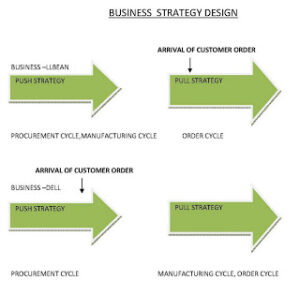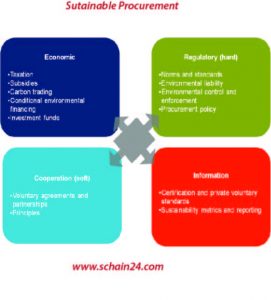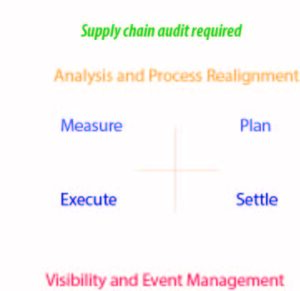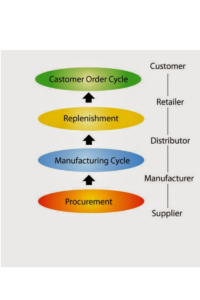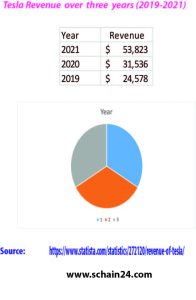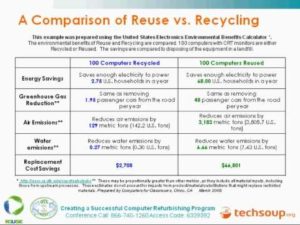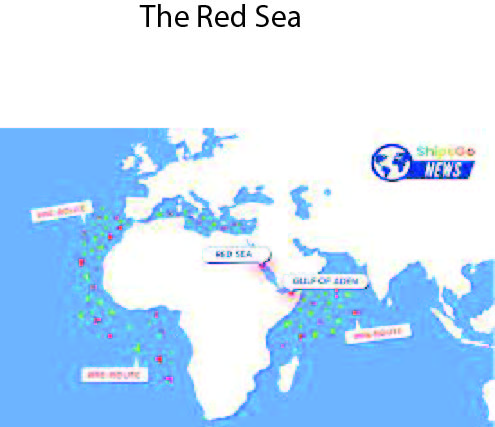
Abstract
The Red Sea, a major sea route connecting Europe, the Persian Gulf, and East Asia, is facing increased attacks by Houthi insurgents in Yemen since mid-November 2023. The US has announced a maritime coalition to defend shipping in the area. The Eastern shore includes Saudi Arabia and Yemen, while the Western shore includes Egypt, Sudan, Eritrea, and Djibouti. Maersk has halted all transits through the Red Sea/Gulf of Aden until further notice, while Hapag-Lloyd has extended its rerouting around Africa. CMA CGM has announced rate increases from Asia to North Europe, and carriers are redirecting Asia to US East Coast services via Panama.
Keywords: The Red Sea Supply Chain
Introduction
The International Hydrographic Organization defines the limits of the Red Sea as follows:On the North. The Southern limits of the Gulfs of Suez [A line running from Ràs Muhammed (27°43’N) to the South point of Shadwan Island (34°02’E) and thence Westward on a parallel (27°27’N) to the coast of Africa] and Aqaba [A line running from Ràs al Fasma Southwesterly to Requin Island (27°57′N 34°36′E) through Tiran Island to the Southwest point thereof and thence Westward on a parallel (27°54’N) to the coast of the Sinai Peninsula]. On the South. A line joining Husn Murad (12°40′N 43°30′E) and Ras Siyyan (12°29′N 43°20′E). In the global shipping arena Red Sea is very important and any disruption in this area increase of shipping time and cost happens.
The Red Sea is part of the sea roads between Europe, the Persian Gulf and East Asia, and as such has heavy shipping traffic. Government-related bodies with responsibility to police the Red Sea area include the Port Said Port Authority, Suez Canal Authority and Red Sea Ports Authority of Egypt, Jordan Maritime Authority, Israel Port Authority, Saudi Ports Authority and Sea Ports Corporation of Sudan. Houthi insurgents in Yemen have increased attacks on shipping vessels since mid-November 2023. The US has announced a maritime coalition to defend shipping in the Red Sea.
Eastern and Western shore
Eastern shore: Saudi Arabia and Yemen. On the other hand Western shore comprises of Egypt, Sudan, Eritrea and Djibouti. Cities and ports on the bank of Red Sea are as follows: Ain Sokhna, Egypt , Al Hudaydah, Yemen, Al Lith, Saudi Arabia ,Al Qunfudhah, Saudi Arabia, Al-Qusair , Egypt, Al Waih , Saudi Arabia, Aqaba, Jordan, Asseb, Eritrea, Dahab, Egypt, Duba, Saudi Arabia, Eilat, Israel,El Gouna, Egypt,El Tor, Egypt, Suez , Egypt, Hala;ib , Egypt and Sudan, (disputed), Haql, Saudi Arabia, Hirgigo , Eritrea, Hurghada , Egypt , Jeddah , Saudi Arabia, Jazan , Saudi Arabia, Marsa Alam , Egypt, Massawa , Eritrea, Mokha , Yemen, Moulhoule , Djibouti, Nuweiba , Egypt , Port Sudan , Sudan , Rabigh , Saudi Arabia , Safaga, Egypt,Sharm El Sheikh, Egypt ,Soma Bay, Egypt, Suakin , Sudan,Taba, Egypt,Thuwal, Saudi Arabia and Yanbu, Saudi Arabia. Somalia is also considered country near Red Sea.
Recent shipping issues in Red Sea
Maersk Decided that all transits through the Red Sea / Gulf of Aden are halted until further notice. Maersk remains in a holding pattern, with vessels like “Mathilde Maersk” redirecting westwards towards Gibraltar. Hapag-Lloyd has extended its rerouting around Africa for another week before reassessing the Red Sea security situation. Some cargo will move to air mode of shipment. Analysts expect air freight rates to rise.
Carrier Responses
CMA CGM has announced rate increases from Asia to North Europe, escalating from $2000/FFE to $6000/FFE by mid-January.The Federal Maritime Commission in the US is allowing carriers to publish new tariffs with shorter notice due to these disruptions. Carriers are redirecting Asia to US East Coast services via Panama instead of Africa. However, issues with the Panama Canal persist and normality is not expected until mid-2024.
Conclusion
Red Sea is very essential for some other countries that are not particularly on the bank of Red Sea, such as countries near Mediterranean. These countries are in EU and Israel. Recent insurgent activities near shore increasing the freight rate of the cargo moving through Red sea. And ships are compelled to move though different routes such as Cape of Good Hope.
References:
1.“Limits of Oceans and Seas, 3rd edition” (PDF). International Hydrographic Organization. 1953. Archived (PDF) from the original on 8 October 2011. Retrieved 28 December 2020.
2.Jump up to:ab c d Yerushalmy, Jonathan (20 December 2023). “Red Sea crisis explained: what is happening and what does it mean for global trade?”. The Guardian. Retrieved 3 January 2024.
3.https://wefreight.com/advisory-red-sea-disruptions-continue-to-impact-global-supply-chains/#.
- SEO Powered Content & PR Distribution. Get Amplified Today.
- PlatoData.Network Vertical Generative Ai. Empower Yourself. Access Here.
- PlatoAiStream. Web3 Intelligence. Knowledge Amplified. Access Here.
- PlatoESG. Carbon, CleanTech, Energy, Environment, Solar, Waste Management. Access Here.
- PlatoHealth. Biotech and Clinical Trials Intelligence. Access Here.
- Source: https://www.schain24.com/2024/01/12/the-red-sea-a-discussion-in-a-supply-chain-perspective/
- :has
- :is
- :not
- $UP
- 1
- 14
- 20
- 2011
- 2020
- 2023
- 2024
- 24
- 28
- 3rd
- 7
- 8
- 9
- a
- ABSTRACT
- activities
- africa
- AIR
- AL
- All
- Allowing
- also
- Analysts
- and
- announced
- Another
- any
- Archive
- ARE
- AREA
- Arena
- around
- AS
- asia
- Attacks
- authority
- auto
- Bank
- Bay
- before
- between
- bodies
- by
- cape
- Cargo
- carriers
- chain
- Cities
- CMA
- coalition
- Coast
- COM
- commission
- compelled
- comprises
- conclusion
- Connecting
- considered
- content
- CORPORATION
- Cost
- countries
- country
- crisis
- December
- decided
- Defines
- different
- discussion
- Disruption
- disruptions
- Djibouti
- does
- due
- East
- east coast
- eastern
- Egypt
- el
- essential
- EU
- Europe
- expect
- expected
- explained
- extended
- facing
- Federal
- follows
- For
- freight
- from
- further
- further notice
- Gibraltar
- Global
- global trade
- good
- guardian
- gulf
- hand
- Happening
- happens
- Have
- heavy
- holding
- hope
- However
- HTTPS
- important
- in
- include
- includes
- Increase
- increased
- Increases
- increasing
- instead
- International
- Introduction
- island
- Israel
- issues
- IT
- ITS
- joining
- jonathan
- Jordan
- jpg
- like
- limits
- Line
- Maersk
- major
- Maritime
- mean
- Mediterranean
- Mode
- move
- moving
- Near
- New
- None
- North
- Notice..
- oceans
- october
- of
- on
- organization
- original
- Other
- Panama
- Parallel
- part
- particularly
- Pattern
- perspective
- plato
- Plato Data Intelligence
- PlatoData
- Point
- Police
- ports
- publish
- Rate
- Rates
- recent
- Red
- references
- remains
- responsibility
- Rise
- roads
- Route
- routes
- running
- Said
- Saudi
- Saudi Arabia
- SEA
- security
- Services
- sheikh
- Shipping
- ships
- since
- situation
- some
- South
- Southern
- such
- Sudan
- supply
- supply chain
- table
- tariffs
- that
- The
- The Area
- The Guardian
- These
- this
- though?
- Through
- time
- to
- Tor
- towards
- trade
- traffic
- true
- until
- us
- very
- vessels
- via
- week
- Western
- What
- What is
- while
- Wikipedia
- will
- with
- zephyrnet

